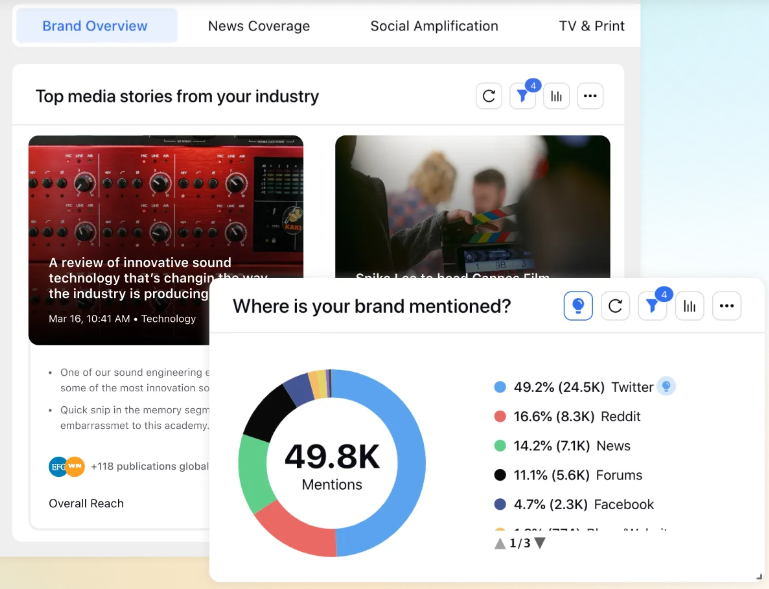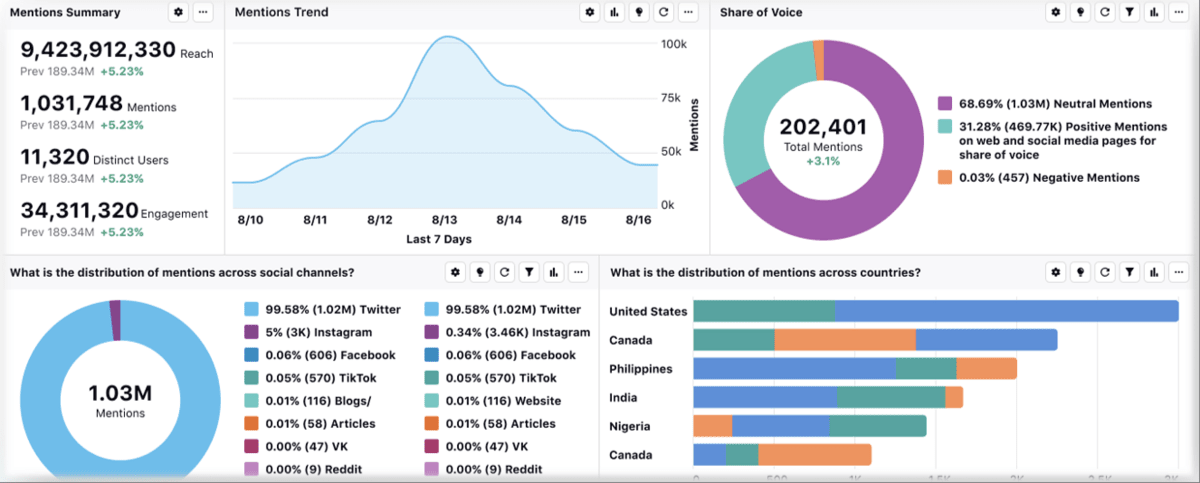You've got the magic touch when it comes to crafting captivating posts. But here's the million-dollar question: How do you transform all that viral buzz into real business success?
It's time to unravel the mystery!
Studies show that the global social media market grew from $193.52 billion in 2022 to $231.1 billion in 2023 and is expected to grow to $434.87 billion in 2027. So, if you want to make those likes, shares and views count, get ready to set some actionable social media goals and watch those profits soar!
In this blog, learn the secrets to setting clear goals that can raise your social media game to the next level.
What are social media goals?
Social media goals are the specific objectives businesses aim to achieve through their social media presence. It could be examples like increasing brand awareness, driving traffic, generating leads, fostering engagement, improving customer service and managing online reputation. They are like the ultimate roadmap for your online adventures — like the GPS that keeps you on track in this wild, wild web.
Social media goals go way beyond getting a bunch of likes and followers. It's all about leveling up your brand and making waves in the digital ocean. It's like having a bag full of magic tricks at your disposal.
Want to be known by everyone and their grandma? Boom! Boost that brand awareness to epic proportions.
Need a virtual traffic jam on your website? No problem! Drive those clicks and visits like a boss.
Oh, and generating leads? It's like fishing with a dynamite bait, reeling in potential customers. And let's not forget about the art of engaging your audience like a rockstar, turning your followers into the ultimate fan club. Last but not least, there's the whole reputation game — building a shiny brand image that shines brighter than a disco ball.
Importance of setting actionable social media goals
Setting clear, actionable goals is less about ticking boxes and more about steering your campaigns to success.
Here’s why it's critical to set well-defined goals in your social media strategy:
Sharpens your focus: Clear goals keep your social media efforts targeted. Whether you’re aiming to increase brand awareness, boost engagement or drive sales, specific goals allow you to concentrate resources on tactics that move the needle.
Keeps everyone on their toes: With set goals, teams have a benchmark against which they can measure their progress. This not only instills a sense of responsibility but also helps in identifying areas needing improvement. It turns daily social media activities into purpose-driven tasks.
Smarter choices: Knowing your end goal influences your decisions along the way. Which platforms to hit hard, where to put your dollars and what kind of content to push? All these decisions get a whole lot simpler.
Tracks your wins: When you have specific goals, measuring the social media return on investment (ROI) becomes easier. You can track relevant metrics and assess whether your social media activities are contributing to the business objectives, helping you justify spending and adjust strategies as needed.
Fuels drive and creativity: Having a clear goal gets the creative juices flowing. It’s motivating, pushing your team to break the mold with fresh, engaging content that strikes a chord with your audience.
Setting actionable goals means every post or campaign is pulling its weight towards your bigger business aims. It's about making your mark, proving your worth and doing it all with a clear direction in mind.
Steps to define social media goals
If you’re ready to level up your social media game, here are the essential steps to define successful social media goals. From knowing your objectives to setting SMART targets and monitoring your progress, get ready to unlock the secrets of social media success:
Tip: Create your social media goals strategically using Sprinklr Social by analyzing the best-performing metrics for your social media accounts.
Step 1: Know your objectives
First, understand your business objectives and what you aim to achieve through social media. Is it increasing brand awareness, driving website traffic, generating leads or boosting customer engagement? Knowing your objectives sets the foundation for defining impactful social media goals.
Step 2: Identify key metrics
Determine the social media metrics that align with your objectives. These could be metrics like reach, impressions, engagement rate, website click-throughs, conversion rate or customer acquisition cost. Choose metrics that provide meaningful insights into your social media performance and help you track progress toward your goals.
Step 3: Make it SMART
Make your goals SMART: Specific, Measurable, Achievable, Relevant and Time-bound. For example, instead of a vague goal like "increase social media engagement," a SMART goal would be "increase average post engagement rate by 15% in the next three months." Being specific and time-bound makes your goals actionable and easier to track.
Step 4: Set priorities
You might have multiple goals, but it's crucial to prioritize them based on their importance and alignment with your business objectives. Focus on the goals that have the most significant impact on your brand objectives.
Step 5: Break your goals down
Break down your goals into smaller milestones or mini-goals. This makes them less daunting and allows you to track progress along the way. For instance, if your goal is to increase website traffic, you can set milestones to achieve specific monthly or quarterly increases.
Step 6: Monitor, measure and adjust
Regularly monitor your social media performance using social media management tools. Determine whether you have met your set goals and evaluate what's working and what’s not. If you don’t hit your targets, don't fret — adjust strategies, test new approaches and refine goals as necessary so you keep making progress!
Learn More: Social Media Strategy: Follow 11 Steps & Get Results
Following these steps, you can set social media goals that reflect your business objectives. Keep reading to find out the importance of social media KPIs when setting social media goals.
Social media goal examples with KPIs
Below are a few social media goal examples, accompanied by their trusty sidekicks —Key Performance Indicators (KPIs):
1. Boost brand awareness
Brand awareness aims to increase brand visibility among target audiences.
Did you know that 70% of social marketers prioritize brand awareness? Social media platforms provide an effective platform to reach wider audiences. By taking advantage of social media platforms, your brand can extend its reach and impressions.
Potential KPIs to measure brand awareness include:
Social media reach: the number of unique users who see your content, indicating the potential reach and visibility of your brand
Impressions: the number of times your content is displayed, providing insight into how frequently users come across your brand's messaging.
Brand mentions: instances where your brand is mentioned on social media, indicating organic conversations and brand visibility
Follower growth: the increase in the number of followers on your social media accounts, reflecting the growth of your brand's online community
2. Drive traffic to your website
Improving engagement on social media should aim at driving users directly to your website, where they can explore your products, services or content in greater depth. According to research conducted on GenZ and millennial users, 28% are more likely to purchase new items after seeing them on social media first.
Optimizing your social media efforts by providing engaging content and call-to-actions will increase click-through rates (CTR), thus driving more visitors to your website.
Potential KPIs to measure traffic include:
Click-through rate (CTR): CTR measures how often people click through links that lead them directly to your website, providing insight into its effectiveness in driving traffic
Website sessions: these refer to the total number of users who visited your website from social media platforms, representing its traffic volume
Bounce rate: this percentage measures the percentage of users who leave your website after visiting only one page, helping evaluate its relevance and quality of content
Average session duration: the length of time users spend browsing your site reflects engagement and interest in its content
3. Increase engagement
Increasing engagement involves fostering meaningful interactions and creating a buzzing community around your brand on social media. Did you know that 54% of social media users use social media to research products? It's about building relationships and encouraging users to actively engage with your content through likes, comments, shares and mentions. Higher engagement rates not only indicate an active and interested audience but also contribute to increased brand visibility and word-of-mouth recommendations. A study revealed that 70% of emotionally engaged consumers spend two times (or more) on a brand they are loyal to.
Read more - BFSI: 3 Steps to Build a Killer Social Media Brand and Grow your Sales from GenZ
Potential KPIs to measure engagement include:
Engagement rate: the percentage of users who engage with your content through likes, comments, shares and other actions, reflecting the level of interest and involvement
Likes, comments, shares: quantitative measures of the interactions your content receives, showing the engagement and reach of your posts
Mentions: instances where your brand is mentioned by users, indicating the level of brand awareness and the potential for conversations and collaborations
4. Generate quality leads
The goal of lead generation is to capture potential customers and guide them into your sales funnel. Research indicates that 61% of marketers see lead generation as their top challenge. Through social media, you can encourage users to take desired actions, such as filling out lead forms, downloading gated content or signing up for your email list.
Potential KPIs to track social media lead generation include:
Conversion rate: the percentage of users who take a desired action, such as filling out a lead form or making a purchase, measuring the effectiveness of your campaigns in generating leads
Lead form submissions: the number of users who submit their information through lead capture forms, indicating the volume of potential leads
Downloads of gated content: the number of users who access valuable content by providing their contact information, indicating lead generation potential
Email sign-ups: the number of users who subscribe to your email list, showing interest in receiving further communication and nurturing as potential leads
5. Enhance customer satisfaction
Enhancing customer satisfaction involves providing exceptional customer support and engaging with customers on social media platforms. 63% of customers expect companies to offer customer service through their social media channels. Promptly responding to customer inquiries, resolving issues efficiently and maintaining a positive sentiment in customer interactions are key factors in ensuring customer satisfaction.
Potential KPIs to track customer service effectiveness include:
Response time: the average time taken to respond to customer inquiries or messages, indicating the efficiency and promptness of your customer support
Customer satisfaction rating: feedback or survey-based ratings reflecting customers' level of satisfaction with your brand's support and engagement efforts
Resolution rate: the percentage of customer issues or inquiries resolved successfully, indicating the effectiveness of your support team
Sentiment analysis: analyzing customer sentiment in comments or messages, identifying positive or negative feedback and adjusting strategies accordingly
💡 Pro Tip: Wondering how to track these sentiments? Try social listening! By monitoring keywords related to your brand and competitors, this tool uses AI to categorize mentions as positive, negative or neutral and identifies key topics your audience discusses. This allows you to refine your marketing strategies, tailor responses and boost sales effectively.

Test the pulse of your audience with a free trial of Sprinklr today 👇
6. Drive sales and revenue
Social media sales and revenue generation are intended to affect your brand's line directly. By optimizing social media campaigns, targeting specific audiences and employing persuasive strategies, you can increase conversion rates and generate additional revenues; social interactions often prompt customers to spend 20-40% more money when purchasing products/services from brands like yours!
Potential KPIs to track social media conversions include:
Conversion rate: the percentage of users who make a purchase or complete a desired action, measuring the effectiveness of your social media campaigns in driving sales
Revenue generated: the total monetary value generated from social media sales, reflecting the direct impact on your business's bottom line
Average order value: the average value of each purchase made through social media, providing insights into customer spending habits
Return on ad spend (ROAS): the ratio of revenue generated to the cost of advertising
Remember, these are just a few examples to inspire your ideas. The key is to align your social media goals with your business objectives and choose KPIs that directly measure your progress toward those goals.
How to track and measure your social media progress
Tracking and measuring social media progress is vital to understanding what's working and what isn't. Here's a quick guide that can help:
Set clear goals: Start by defining your social media goals. Whether it's increasing brand awareness, driving website traffic or boosting engagement, having clear objectives will give you direction and purpose.
Utilize analytics tools: Use analytics tools provided by platforms like Facebook, X and Instagram. They give you insights into your audience demographics, engagement patterns and content performance.
Keep your social media on track with an advanced social analytics platform!
Ever wish you had a crystal ball to see how your social media efforts are paying off?
Enter Sprinklr’s Social Analytics Platform — it’s almost like having one! This tool isn’t just about numbers; it’s about insights that help you understand the impact of your social media strategies in real-time, that too from 30+ digital channels.
With Sprinklr, you can:
📊 Monitor performance effortlessly: Track your campaigns, posts and overall social health all from one dashboard.
🔍 Deep dive into data: Get detailed reports that tell you what's working, what's not and why.
🎯 Make informed decisions: Armed with data, you can tweak your strategies to ensure they’re hitting the mark.

Ready to take your social media game to the next level?
Keep an eye on key metrics: Track important metrics to measure your progress. Look at reach, impressions, engagement rate and CTRs. These numbers reveal how many people your content is reaching out to and who is engaging and taking action on it.
Conversion tracking: Don't forget to set up conversion tracking on your website to determine whether your social media efforts translate to lead generation and sales. Measure the actions users take on your site, like form submissions, downloads or purchases.
Experiment and learn: Social media marketing is all about trial and error. Don't be intimidated to explore different strategies, content formats and best posting times for social media until you discover which are best received by your audience.
Engage, Engage, Engage: Building relationships is key! Engage with your audience by responding to comments, messages and mentions. Encourage conversation, ask questions and show that you're listening. This interaction creates a real connection and helps you understand your audience better.
Regular evaluation: Take time to evaluate your social media efforts regularly. Analyze the data, review your goals and make adjustments as needed. Keep up with trends, stay agile and adapt your strategy accordingly.
Interesting Read: Social Media Reports: A Basic-to-Advanced Level Guide
So there you have it! Following these tips, to soon be on your way to tracking and measuring social media progress like a pro. And with Sprinklr Social, a powerful social media management platform, you can take your social media efforts to the next level. Remember, social media is a journey of discovery, learning and establishing meaningful connections that should not be taken lightly.
Final thoughts
Setting social media goals is like discovering a hidden treasure map to your brand's success. It keeps you on track and can be your North Star in the ever-changing digital landscape. So, dare to dream big, define your goals clearly and embark on an exciting journey of experimentation, engagement and evaluation.
As Maya Angelou said, "Success is liking yourself, liking what you do and liking how you do it." Take the time to reflect on your brand's values, define clear objectives and approach social media with authenticity and passion. With each goal achieved, you'll unlock new horizons, forge meaningful connections and watch your brand's influence grow. So, take that leap of faith, set your social media goals and let your unique story unfold with every post, like, comment and share. Your brand's destiny awaits!




![10 AI Writing Prompts In Content Marketing [2024]](https://images.ctfassets.net/ukazlt65o6hl/7BXUq8Ns0vCgornXApT0Uz/572755ba099aecf279675903caf526b6/Blog_Banner_Image.png?w=750&h=505&fl=progressive&q=70&fm=jpg)
